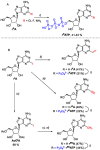Synthesis of 2-Substituted Adenosine Triphosphate Derivatives and their use in Enzymatic Synthesis and Postsynthetic Labelling of RNA
- PMID: 40317833
- PMCID: PMC12177693
- DOI: 10.1002/cbic.202500241
Synthesis of 2-Substituted Adenosine Triphosphate Derivatives and their use in Enzymatic Synthesis and Postsynthetic Labelling of RNA
Abstract
A series of adenosine triphosphate (ATP) derivatives bearing chloro, fluoro, amino, methyl, vinyl, and ethynyl groups at position 2 are synthesized and tested as substrates for RNA and DNA polymerases. The modified nucleotides work well in in vitro transcription with T7 RNA polymerase and primer extension (PEX) using engineered DNA polymerases (TGK, 2M) except for the bulkier 2-vinyl- and 2-ethynyl-ATP derivatives that give truncated products. However, in single nucleotide incorporation followed by PEX, they still can be used for site-specific incorporation of reactive modifications into RNA that can be further used for postsynthetic labeling through thiol-ene or Cu-catalyzed alkyne-azide cycloadditions reactions. All modified ATPs work in polyadenylation catalyzed by poly(A) polymerase to form long 3'-polyA tails containing the modifications that also can be used for labeling.
Keywords: DNA polymerases; RNA polymerases; click reactions; nucleosides triphosphates; nucleotides; polyA polymerase; thiol‐ene addition.
© 2025 The Author(s). ChemBioChem published by Wiley‐VCH GmbH.
Conflict of interest statement
The authors declare no conflict of interest.
Figures







Similar articles
-
Polymerase Synthesis of Hypermodified DNA Displaying a Combination of Thiol, Hydroxyl, Carboxylate, and Imidazole Functional Groups in the Major Groove.Chemistry. 2025 Jun 17;31(34):e202501034. doi: 10.1002/chem.202501034. Epub 2025 May 15. Chemistry. 2025. PMID: 40327399 Free PMC article.
-
Assessing the comparative effects of interventions in COPD: a tutorial on network meta-analysis for clinicians.Respir Res. 2024 Dec 21;25(1):438. doi: 10.1186/s12931-024-03056-x. Respir Res. 2024. PMID: 39709425 Free PMC article. Review.
-
Enzymatic synthesis of base-modified RNA by T7 RNA polymerase. A systematic study and comparison of 5-substituted pyrimidine and 7-substituted 7-deazapurine nucleoside triphosphates as substrates.Org Biomol Chem. 2018 Aug 15;16(32):5800-5807. doi: 10.1039/c8ob01498a. Org Biomol Chem. 2018. PMID: 30063056
-
Synthesis and evaluation of an alkyne-modified ATP analog for enzymatic incorporation into RNA.Bioorg Med Chem Lett. 2016 Apr 1;26(7):1799-802. doi: 10.1016/j.bmcl.2016.02.038. Epub 2016 Feb 18. Bioorg Med Chem Lett. 2016. PMID: 26927424 Free PMC article.
-
Controversies and clinical unknowns in the use of PARP inhibitors in ovarian cancer.Ther Adv Med Oncol. 2025 Jun 14;17:17588359251343973. doi: 10.1177/17588359251343973. eCollection 2025. Ther Adv Med Oncol. 2025. PMID: 40529205 Free PMC article. Review.
References
-
- Androsavich J. R., Nat. Rev. Drug Discovery 2024, 23, 421. - PubMed
MeSH terms
Substances
Grants and funding
LinkOut - more resources
Full Text Sources

